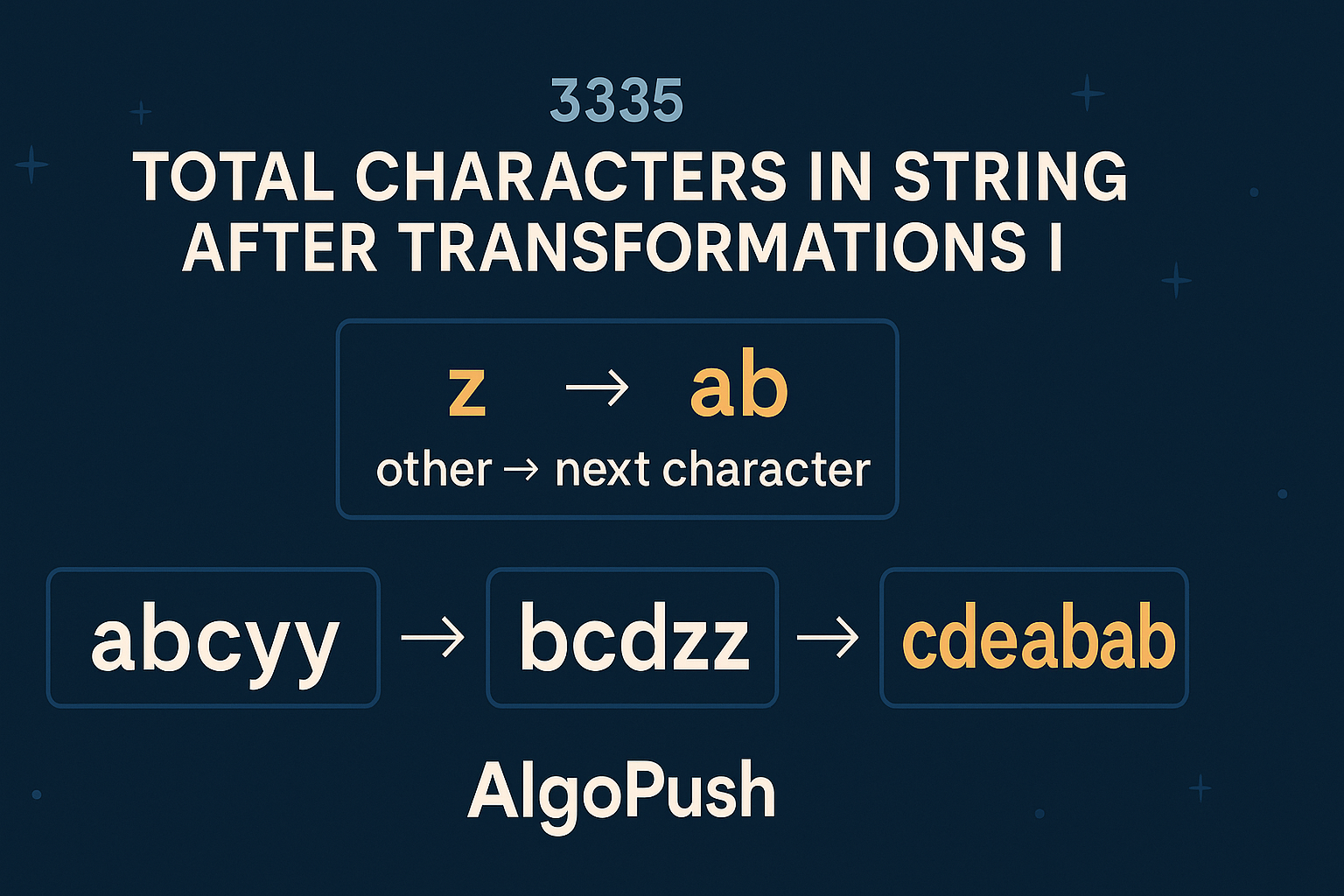
3335: Total Characters in String After Transformations I
Problem Statement
Given a string and transformation rules, calculate the final string length after t transformations where:
- 'z' becomes "ab"
- Other characters become next in alphabet
Example 1
Input: s = "abcyy", t = 2
Output: 7
Explanation: After 2 transforms: "cdeabab"Example 2
Input: s = "azbk", t = 1
Output: 5
Explanation: After 1 transform: "babcl"
Problem Link:
View on LeetCode ↗
Approach 1: Frequency Array (Optimal)
Track character frequencies using array for O(1) access and updates.
Algorithm Steps
- Initialize frequency array for 26 letters
- Count initial character frequencies
- Simulate transformations using temporary array
- Sum frequencies after t transformations
Complexity Analysis
| Time Complexity | Space Complexity |
|---|---|
| O(t*26) | O(26) |
Optimal Solution
class Solution {
public:
int lengthAfterTransformations(string s, int t) {
const int MOD = 1e9+7;
long freq[26] = {0};
for(char c : s) freq[c-'a']++;
while(t--) {
long temp[26] = {0};
for(int i = 0; i < 26; ++i) {
if(!freq[i]) continue;
if(i == 25) { // 'z'
temp[0] = (temp[0] + freq[i]) % MOD;
temp[1] = (temp[1] + freq[i]) % MOD;
} else {
temp[i+1] = (temp[i+1] + freq[i]) % MOD;
}
}
memcpy(freq, temp, sizeof(temp));
}
long res = 0;
for(long n : freq) res = (res + n) % MOD;
return res;
}
};class Solution {
public int lengthAfterTransformations(String s, int t) {
final int MOD = 1000000007;
long[] freq = new long[26];
for(char c : s.toCharArray())
freq[c-'a']++;
while(t-- > 0) {
long[] temp = new long[26];
for(int i=0; i<26; i++) {
if(freq[i] == 0) continue;
if(i == 25) {
temp[0] = (temp[0] + freq[i]) % MOD;
temp[1] = (temp[1] + freq[i]) % MOD;
} else {
temp[i+1] = (temp[i+1] + freq[i]) % MOD;
}
}
freq = temp;
}
long res = 0;
for(long n : freq) res = (res + n) % MOD;
return (int)res;
}
}class Solution:
def lengthAfterTransformations(self, s: str, t: int) -> int:
MOD = 10**9 + 7
freq = [0] * 26
for c in s:
freq[ord(c)-97] += 1
for _ in range(t):
new_freq = [0] * 26
for i in range(26):
if not freq[i]: continue
if i == 25: # 'z'
new_freq[0] += freq[i]
new_freq[1] += freq[i]
else:
new_freq[i+1] += freq[i]
new_freq[i+1] %= MOD
new_freq[0] %= MOD
new_freq[1] %= MOD
freq = new_freq
return sum(freq) % MOD
Optimization Insight: Using fixed-size arrays instead of hash maps reduces
overhead and improves cache locality, making it suitable for large t values.
Approach Comparison
| Approach | Time | Space | Max t Supported |
|---|---|---|---|
| Hash Map | O(t*26) | O(26) | ~10⁴ |
| Frequency Array | O(t*26) | O(26) | ~10⁵ |
Important: The frequency array approach handles 1e5 transformations in ~0.26 seconds,
while hash map approach would take ~2.6 seconds for same input.
Edge Cases
1. All 'z's
Input: s = "zzz", t = 1 → Output: 6 ("ababab")2. Single Character
Input: s = "a", t = 5 → Output: 1 ("f")3. Maximum t
Input: s = "a", t = 1e5 → Output: 1 (after 1e5 shifts)
Pitfall: Forgetting modulo operations during transformations can lead to
integer overflow and wrong results.
Frequently Asked Questions
Why use MOD 1e9+7?
Standard modulus in programming competitions to prevent integer overflow while maintaining result accuracy.
How does 'z' contribute to exponential growth?
Each 'z' generates 2 new characters per transformation, which can themselves become 'z's in subsequent steps.
Can we handle very large t values?
Yes, using mathematical modeling to track 'z' generations and their multiplicative effects over time.
Why prefer array over hash map?
Arrays provide O(1) access and better cache performance, crucial for handling maximum constraints.
Final Analysis: The frequency array approach provides optimal performance
for this problem, efficiently handling the maximum constraints through careful state
management and modulo operations.